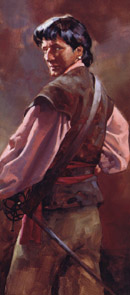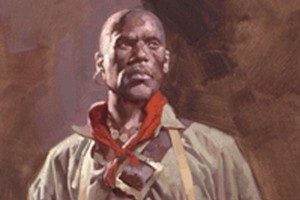
John Julian (c. 1701 – 26 March 1733, aged 32) was the first recorded black pirate to operate in the New World, as the pilot of the ship Whydah.
Julian was a half-blood Miskito Indian who joined Samuel Bellamy early in his brief career. He became a pilot for the Whydah at 16 years old, an important assignment that would require him to use his vast navigational skills to guide the Whydah into narrow coves to hide from navy ships. Julian was one of 30 to 50 people of African descent in the pirate crew — all were treated as equals.
A purported “unruly slave,” Julian the Indian was sold to another owner and tried often to escape. During one attempt, he killed a bounty hunter who was trying to catch him. He was executed on March 26, 1733.
Hendrich Quintor, a free black man of Dutch and African descent, “went on the account” when the Spanish brigantine he was aboard was captured by French pirates in the early 1700’s. He was one of 30 seamen of African descent on board the Whydah, along with about 20 more black pirates on the other ships in “Black” Sam Bellamy’s flotilla. Quintor, perhaps the son of a sailor, spent most of his life at sea. After joining the pirates of the Whydah, Quintor earned a reputation as one of the toughest pirates on the ship.
Quintor was not aboard the Whydah when she sank in 1717. But he didn’t survive long after. He was captured in 1717, found guilty of piracy, and was sentenced to death by hanging. The town square was packed near the gallows where Quintor and five other pirates met their death. To the audience, it was entertainment.
A mulatto born in Amsterdam in 1692, Quintor served proudly aboard the Whydah, a pirate shipwreck site discovered in 1984 by underwater explorer Barry Clifford and his team. Clifford continues to direct the ongoing excavation of the wreck in a project that has been described by state and federal regulatory agencies as “a model for private archaeology”. The National Geographic Real Pirates website said “commissioned in London in 1715, the Whydah was originally built to carry slaves from Africa to the New World. Cramped compartments in the ship’s hold were constructed to house human cargo on their journey to Caribbean sugar plantations. As a slave ship, the Whydah‘s state-of-the art design included a sleek silhouette that made the ship unusually fast and maneuverable. An arsenal of weapons provided defense against attacks by African and European warships—or pirates.”
The Whydah left on her maiden voyage in early 1716, traveling out the English Channel and into the Atlantic, where she then turned south toward Africa. Like other slave ships, she worked her way around the West African coast from modern Gambia and Senegal to Nigeria and Benin, picking up captives along the way. Eventually she landed in Ouidah (Wee-dah)—the slave port from which the Whydah had taken her name.
On the evening of April 26, 1717, a dense fog rolled in. An arctic gale from Canada was colliding with a warm front moving northward from the Caribbean. Their confluence produced one of the worst storms ever to strike Cape Cod. The nor-easter hit the Whydah full force. The ship ran hard aground on a sandbar. The mainmast and other rigging snapped like twigs, and the Whydah rolled over. Although the beach was just 500 feet away, the bitter ocean temperatures were cold enough to kill the strongest swimmer within minutes.
Of the 146 men aboard the Whydah that night, only two survived. Somehow Thomas Davis, the carpenter, and John Julian, the Miskito pilot, managed to swim to shore and scale the steep sand cliffs. Young John King—the boy who threatened to kill himself if he couldn’t to join the pirate crew—did not survive. He died pinned to the seabed by a cannon, his leg bone, shoe, and stocking, later discovered by Barry Clifford’s Whydah Expedition.
***Information courtesy of Wikipedia.org, Voyagetodiscovery.org, and nauticus.org***


